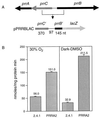The default state of the membrane-localized histidine kinase PrrB of Rhodobacter sphaeroides 2.4.1 is in the kinase-positive mode
- PMID: 11698369
- PMCID: PMC95521
- DOI: 10.1128/JB.183.23.6807-6814.2001
The default state of the membrane-localized histidine kinase PrrB of Rhodobacter sphaeroides 2.4.1 is in the kinase-positive mode
Abstract
The PrrBA two-component activation system of Rhodobacter sphaeroides plays a major role in the induction of photosynthesis gene expression under oxygen-limiting or anaerobic conditions. The PrrB histidine kinase is composed of two structurally identifiable regions, the conserved C-terminal kinase/phosphatase domain and the N-terminal membrane-spanning domain with six transmembrane helices framing three periplasmic and two cytoplasmic loops. Using a set of PrrB mutants with lesions in the transmembrane domain, we demonstrate that the central portion of the PrrB transmembrane domain including the second periplasmic loop plays an important role in both sensing and signal transduction. Signal transduction via the transmembrane domain is ultimately manifested by controlling the activity of the C-terminal kinase/phosphatase domain. The extent of signal transduction is determined by the ability of the transmembrane domain to sense the strength of the inhibitory signal received from the cbb(3) terminal oxidase (J.-I Oh, and S. Kaplan, EMBO J. 19:4237-4247, 2000). Therefore, the intrinsic ("default") state of PrrB is in the kinase-dominant mode. It is also demonstrated that the extent of prrB gene expression is subject to the negative autoregulation of the PrrBA system.
Figures





Similar articles
-
Reconstitution of the Rhodobacter sphaeroides cbb3-PrrBA signal transduction pathway in vitro.Biochemistry. 2004 Jun 22;43(24):7915-23. doi: 10.1021/bi0496440. Biochemistry. 2004. PMID: 15196036
-
Oxygen-insensitive synthesis of the photosynthetic membranes of Rhodobacter sphaeroides: a mutant histidine kinase.J Bacteriol. 1995 May;177(10):2695-706. doi: 10.1128/jb.177.10.2695-2706.1995. J Bacteriol. 1995. PMID: 7751278 Free PMC article.
-
Dominant role of the cbb3 oxidase in regulation of photosynthesis gene expression through the PrrBA system in Rhodobacter sphaeroides 2.4.1.J Bacteriol. 2007 Aug;189(15):5617-25. doi: 10.1128/JB.00443-07. Epub 2007 Jun 8. J Bacteriol. 2007. PMID: 17557830 Free PMC article.
-
Stimulus perception in bacterial signal-transducing histidine kinases.Microbiol Mol Biol Rev. 2006 Dec;70(4):910-38. doi: 10.1128/MMBR.00020-06. Microbiol Mol Biol Rev. 2006. PMID: 17158704 Free PMC article. Review.
-
Eubacterial signal transduction by ligands of the mammalian peripheral benzodiazepine receptor complex.Proc Natl Acad Sci U S A. 1997 May 13;94(10):4821-2. doi: 10.1073/pnas.94.10.4821. Proc Natl Acad Sci U S A. 1997. PMID: 9144147 Free PMC article. Review. No abstract available.
Cited by
-
In vivo sensitivity of blue-light-dependent signaling mediated by AppA/PpsR or PrrB/PrrA in Rhodobacter sphaeroides.J Bacteriol. 2009 Jul;191(13):4473-7. doi: 10.1128/JB.00262-09. Epub 2009 Apr 24. J Bacteriol. 2009. PMID: 19395480 Free PMC article.
-
Photosynthesis genes and their expression in Rhodobacter sphaeroides 2.4.1: a tribute to my students and associates.Photosynth Res. 2002;73(1-3):95-108. doi: 10.1023/A:1020437317471. Photosynth Res. 2002. PMID: 16245109
-
RegB/RegA, a highly conserved redox-responding global two-component regulatory system.Microbiol Mol Biol Rev. 2004 Jun;68(2):263-79. doi: 10.1128/MMBR.68.2.263-279.2004. Microbiol Mol Biol Rev. 2004. PMID: 15187184 Free PMC article. Review.
-
Development of the bacterial photosynthetic apparatus.Curr Opin Microbiol. 2006 Dec;9(6):625-31. doi: 10.1016/j.mib.2006.10.005. Epub 2006 Oct 20. Curr Opin Microbiol. 2006. PMID: 17055774 Free PMC article. Review.
-
Regulation of the Rhodobacter sphaeroides 2.4.1 hemA gene by PrrA and FnrL.J Bacteriol. 2008 Oct;190(20):6769-78. doi: 10.1128/JB.00828-08. Epub 2008 Aug 8. J Bacteriol. 2008. PMID: 18689483 Free PMC article.
References
-
- Bird T H, Du S, Bauer C E. Autophosphorylation, phosphotransfer, and DNA-binding properties of the RegB/RegA two-component regulatory system in Rhodobacter capsulatus. J Biol Chem. 1999;274:16343–16348. - PubMed
-
- Dutta R, Qin L, Inouye M. Histidine kinases: diversity of domain organization. Mol Microbiol. 1999;34:633–640. - PubMed
Publication types
MeSH terms
Substances
Grants and funding
LinkOut - more resources
Full Text Sources

